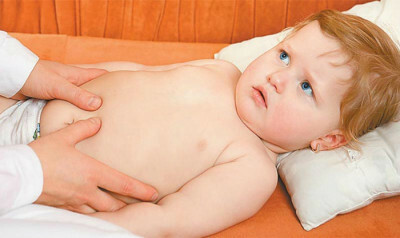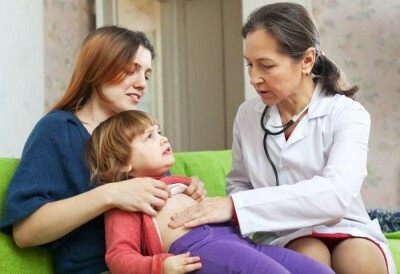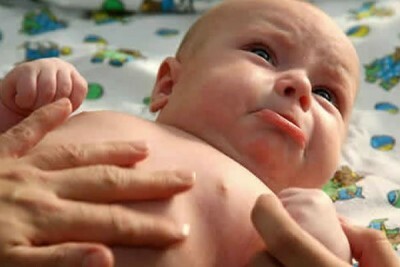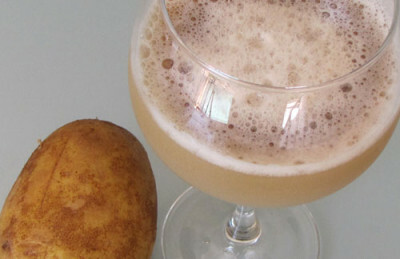1 How and why does my stomach hurt?
When a child has a very sore stomach, then in medicine it is customary to call this pain abdominal. In other words, the child has a very bad feeling in the navel, lower abdomen or epigastric region, which is a symptom of many pathologies.

Recommended to read
- Inguinal hernia in a child
- Why a girl has a stomach ache
- Constantly sore stomach
- Effective remedy for gastritis and stomach ulcer
2 The causes of pain in the abdomen
And yet, why does the child have a feeling of pain in the abdomen? What are the reasons for this? Pain in the abdomen of the child occurs for the following main reasons:
- the child's stressful situations and some psycho-emotional stress;
- various ailments of all the organs of the digestive tract;
- for other diseases, such as pneumonia, influenza and some others;
- all kinds of poisoning;
- some types of allergies.
Spasms in the abdomen of a baby can often occur due to its age.
The main cause of pain in children of this age are intestinal colic. This state does not bring the child any danger and does not require an individual approach.
In addition to colic, abdominal pain in infants may be caused by diseases such as:
- inversion of the intestines;
- dysbiosis;
- hernia in the groin;
- constipation;
- is an allergic reaction to certain foods or medications;
- deficiency of lactose.
In children at 1 year of the cause of the pain is completely similar to the causes of the emergence of pain in adults. There is only one exception: children at this age are very rarely exposed to cholelithiasis.
If it hurts in the abdomen of a child in 2 years, then the cause of such unpleasant sensations is acute appendicitis, peritonitis or diverticulitis. By the way, this reason applies to children and 3 years.
 In the case when the pain is observed in a child older than 4 years, then they have no functional character, and have absolutely no connection with the various pathological conditions of all human organs. To compare this feeling of pain in a 4-year-old baby follows the onset of headaches in adults.
In the case when the pain is observed in a child older than 4 years, then they have no functional character, and have absolutely no connection with the various pathological conditions of all human organs. To compare this feeling of pain in a 4-year-old baby follows the onset of headaches in adults.
-
 IMPORTANT TO KNOW! Gastritis? Ulcer? To have a stomach ulcer not turned into cancer, drink a glass. ..Read the article & gt; & gt;
IMPORTANT TO KNOW! Gastritis? Ulcer? To have a stomach ulcer not turned into cancer, drink a glass. ..Read the article & gt; & gt;
In children 8 and 12 years old, the stomach is constantly hurting as a result of some chronic illness.
4 Pain as one of the symptoms of some diseases
Pain in a child often has some specific characteristics in different conditions: the intensity of pain, its strength, periodicity, and much more. In order to easily identify the cause of this very unpleasant symptom, you need to know what features have abdominal pain in various diseases.
ADVICE FROM THE MAIN GASTROENTEROLOGIST
Korotov SV: "I can recommend only one remedy for the rapid treatment of Ulcer and Gastritis, which is now recommended by the Ministry of Health. .." Read testimonials & gt; & gt;
 Pain in the abdomen with certain diseases of the entire abdominal organs:
Pain in the abdomen with certain diseases of the entire abdominal organs:
- Appendicitis. This disease is most often found in children aged 9 to 12. Painful sensations are most often formed around the navel or right in the lower abdomen. The pain is mostly acute. In this case, the ailment of the child, in addition to pain in the abdomen, there are other symptoms, such as: nausea, diarrhea, vomiting, fever above 39 ° C.At this moment the child becomes very restless and capricious.
- If the abdomen is very sore, it can be pneumococcal peritonitis. This disease is most common in girls with 5 years. The baby has a strong sense of pain, especially in the lower abdomen. Pain sensations in this disease do not have a specific place of localization. In the process of development of this disease the child raises the temperature from 38 to 40 ° C, there is frequent vomiting and diarrhea, which has a very unpleasant smell. The general condition of the child at this point is very severe, the skin pales noticeably, the pulse accelerates and the dryness of the tongue is felt. A child at the age of 5 years suffers this disease quite hard.
WE RECOMMEND!
For prophylaxis and treatment of Digestive Gastrointestinal Diseases our readers advise Monastic tea. This unique remedy consists of 9 medicinal herbs useful for digestion, which not only supplement, but also strengthen each other's actions. Monastic tea will not only eliminate all symptoms of the gastrointestinal tract and digestive system, but will also permanently eliminate the cause of its occurrence.
Opinion of doctors. .. "
- Inversion of the intestines. With this disease, painful sensations appear quite sharply, which can cause crying and crying in the baby.
- Strangulated hernia in the groin. Most often, this ailment can be found in infants or in children under 2 years. At the moment of progressing of this disease, the baby vomits, the child starts screaming very hard. At this point, his skin is much paler and sweats.
- Umbilical colic. These feelings of pain in the abdomen can accompany the child as early as 4 years. In general, such an ailment can occur in children under 6 years, sometimes up to 7. This is most often the case for those children who have a sufficiently high psychological susceptibility. Colic can intensify after the child has suffered severe nervous tension or some kind of stress. The skin of the baby at this moment pale.
- Some abnormalities of the gallbladder and all available ducts.
The child often has moderate intensity pain, which often occurs in the upper right abdomen.
Pains can be given to the shoulder, as well as to the neck and shoulder blade. Very often accompanied by vomiting and nausea.
There is still a lot of diseases of the abdominal organs, in which severe abdominal pains in children can appear:
- Enterocolitis. The feeling of pain in this disease is accompanied by mucous diarrhea, which is very unpleasant smell.
- Gastritis. The pain is cramping. The child has some feeling of bursting in the abdomen, as well as nausea and vomiting. Pain occurs often enough, mostly after eating or on an empty stomach.
- Dysentery. Pain moderate, mostly located in the large intestine, accompanied by the rumbling of the abdomen, frequent frequent vomiting and fever.
- Clover invasion. The feeling of pain is very intense and localized in the navel area.
- Typhoid fever. Sensations of pain in this disease are localized in the region of the cecum.
3 What are the types of abdominal pain?
In its origin, the pain can be:
- Visceral. Appears as a result of irritation of all sensitive nerves of the abdominal cavity. It is not localized in one particular place and is capable of radiating to other parts of the child's body.
- Parietal. Due to some irritation of the entire abdominal cavity. The pain has a cutting character and is localized in a certain place. Moreover, such pain can be amplified at the moment of movement. It is parietal pain that can often accompany appendicitis.
- Psychogenic. It is a certain psychosomatic reaction of the child's organism to a particular stressful situation. Such pain is absolutely not accompanied by functional disorders or possible pathologies of the gastrointestinal tract.
- Neurogenic. It is able to appear as a result of the defeat of nerves, which are given to the abdominal wall.
By nature, the pain can be:
- Cramping. Basically, such pain can occur at the time of narrowing the intestinal lumen.
- Constant. Such pain is most relevant to the process of inflammation. If it hurts in the abdomen of the child constantly, then this indicates that in the gastric secretion, in the motor function there are some violations.
-
 Gastroenterologist. IMPORTANT: "I beg you, if you began to worry about abdominal pain, heartburn, nausea, do not in any way do gases. .."Read more & gt; & gt;
Gastroenterologist. IMPORTANT: "I beg you, if you began to worry about abdominal pain, heartburn, nausea, do not in any way do gases. .."Read more & gt; & gt;
The duration of the pain syndrome is:
- Acute. Pain in the abdomen of the child occurs within a few minutes. Very often such a syndrome occurs together with another, no less unpleasant symptomatology. It can occur with appendicitis, ulcers and some other unpleasant diseases. The general condition of the child is able to fully testify to the presence of a disease that can endanger the life of the baby and therefore requires urgent emergency care.
- Chronic. Can be observed in a baby, whose age is three months. At the same time, feelings of pain in the abdominal region of the child may appear periodically. Such sensations often arise in connection with organic or functional impairments of all organs in the peritoneum.
 With regard to babies, the pain is accompanied by the following symptoms:
With regard to babies, the pain is accompanied by the following symptoms:
- by pressing the legs towards the abdomen;
- loss of appetite and total refusal of feeding;
- with some anxiety and irritation;
- by the intensity of the entire wall of the abdominal cavity;
- capriciousness.
5 What methods should I take?
Each parent should know that it is very difficult for the baby to determine the cause of the abdominal pain in the abdomen. That's why, giving unnecessary and ineffective drugs, you can only harm his health. In order to get rid of the pain syndrome, you need to undergo certain treatment of the underlying disease, which provoked this unpleasant symptomatology.
You should immediately seek help from a specialist if the pain senses:
- last more than 6 hours;
- provokes a complete refusal to eat;
- is not allowed to sleep;
- intensifies when the child changes body position;
- is accompanied by frequent vomiting and febrile condition.
One of the following pain syndromes can signal for urgent hospitalization:
- fainting occurs;
- too strong attack of pain;
- limits the movement of the baby;
- missing stool for more than 3 days.
6 What is forbidden to do?
- Give any pain medication before the appearance of a specialist is strictly prohibited. This makes it difficult to give an accurate definition and the establishment of the cause of this pain syndrome.
- To feed the patient.
- Set special enemas or give some laxatives.
- Warm up the place where the pain is localized.
And how can you help your child?
- before the appearance of a doctor, you can put the baby in the place of pain with an ice pack;
- make a light tummy massage in circular motions;
- in case of acute need to give the child a drink.
The most important thing that every parent should remember is that at the slightest symptoms it is necessary to show your child to a specialist who can prescribe the right treatment and prescribe the necessary medications.
And, of course, self-medication on the recommendations and advice of friends is extremely undesirable, since it is fraught with complications. Be healthy!
- 1 How and why does the stomach ache?
- 2 Causes of abdominal pain
- 3 What are the types of abdominal pain?
- 4 Pain, as one of the symptoms of some diseases
- 5 What methods should I take?
- 6 What is forbidden to do?
Most parents wonder why the baby has a stomach ache. And every parent must know for sure why their children have pain in the abdomen, and what should be done in this case.
Abdominal pain in children may appear, regardless of age. They are able to carry all kinds of character and even result from existing problems with digestion, some chronic pathologies or some psychogenic factors.
If the child has abdominal pain, then this problem can not be bypassed in any way, and self-medication in this case can be very dangerous.
Do you have gastritis?
GALINA SAVINA: "How easy is it to cure gastritis at home for 1 month. A proven method - write down a recipe. ..!"Read more & gt; & gt;



